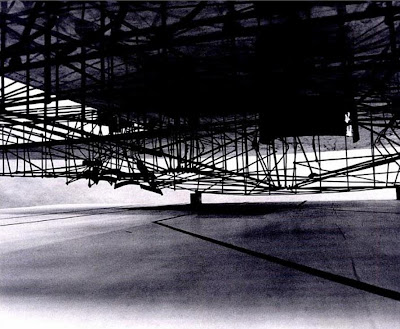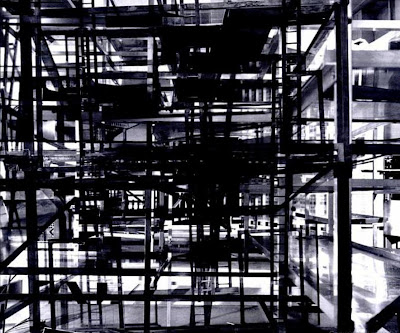Francesco Cingolani is one of the associate of
CTRLZ architectures we already published
here; he also works for
Hugh Dutton Associes in Paris and take part of the blog
Complexitys related to this office. He recently asked me to answer to a
short interview concerning the relationship between engineering and architecture. The original version in French follows the translated one.
(nb there are four other interviews on Complexitys with people coming from very various backgrounds)
Francesco Cingolani: In your vision, what is the relationship between architecture and engineering?
Léopold Lambert: In order to answer to this question, it is important to define what we understand by engineering. If I define here engineering as the discipline that tend to rationalize, diagrammatize, optimize space so then, in my vision, architecture has to try to evolve to the opposite side of this discipline.
Of course, architects would always have to do concessions to technocracy, however to resist to it -and probably resist it with its own language, its own symbols- seems to me as a important attitude.
Last week, one of my teachers, Catherine Ingraham, was evoking the hypothesis that English architects might have an important part of their education dedicated to engineering for reasons that were relative to colonization. In fact, she had the intuition that such an association of architecture and engineering had for goal to materialize and organize in an optimal way the English presence in colonized land. To associate this way Norman Foster and the colonial Bombay's organization is certainly a bold thing to do, nevertheless, even if this hypothesis would be proved to be wrong, I remain convinced that when architecture and engineering are too closely associated, it leads to a space of control. Obviously, I speak here of disciplines in their definitions; by no means I would like to praise architects and speak out against engineers. Actually the important word here is the notion of control. I like this word because it is not connoted and can thus develop an interesting ambiguity. It is not about completely refuse control and engineering, at least for some obvious physical issues; what, in my opinion, should be done is to resist a transcendental absolute control whether the latter comes from the architect or the encompassing institutional system.
FC: We are in an era of great changes: how do you imagine the architect of the future?
LL: I am a bit cautious about this attitude that consist in considering the present era as special. I think we have to work to gather all the circumstances that would make it become this way, but I don't feel it is really the case right now. What I see hidden behind this question is the question of the "green" architecture, but once again, I am cautious about his unique thought that acts like a new religious moral that capitalism did not have too much problem to appropriate.
FC: Nowadays, digital technologies multiply our possibilities and our conception tools: in your job what is your relationship with this complexity that seems to characterize the contemporary world?
LL: I just wrote a short paper for Pratt's journal that illustrate how parametric design allows us to physically access to the spatial complexity depicted in Jorge Luis Borges' short stories.
Previously, the labyrinth was described in two dimensions and was thus controlled in a transcendental way by its author. Borges, by introducing chance and infinite as generative elements of a space, invented uncontrollable architecture in which everybody can get lost.
Those literary spaces, we can now generates them with the help of computation. Using scientific terminology, architecture mostly belongs to the world of physics. Computer allows it to enter in the world of mathematics, and thus, as far as Borges is concerned, to investigate notions of randomness and infinite.
To make an architecture dependent on an equation is yet a vertiginous thing and that is why too many architects and students let themselves go towards a tool idolatry, what we could call an ergaleiophilie (ergaleio in greek means the tool). One should thus use this tool for goals that are external of itself.
original version:
Francesco Cingolani: Quel est, dans ta vision, le rapport entre l’architecture et l’ingénierie?Léopold Lambert:
Afin de répondre a cette question, il convient de définir ce que l’on entend par ingénierie. Si je définis ici l’ingénierie comme la discipline qui tente à rationaliser, diagrammatiser, optimiser l’espace alors, dans ma vision, l’architecture se doit de tenter d’évoluer a l’opposé de cette discipline.Bien sûr, les architectes auront sans doute toujours à faire des concessions a la technocratie, néanmoins, lui résister –et sans doute lui résister avec son propre langage, ses propres symboles- me semble être une attitude libératrice.Une de mes professeurs, Catherine Ingraham, la semaine dernière, évoquait l’hypothèse selon laquelle les architectes anglais avaient une formation approfondie en ingénierie dont les raisons dataient de la colonisation. En effet, elle avait l’intuition qu’une telle association de l’architecture et de l’ingénierie avait pour but de matérialiser et organiser de manière optimale la présence anglaise en terres colonisée. Associer de la sorte Norman Foster et l’aménagement du Bombay colonial est certes une chose audacieuse mais quand bien même cette hypothèse se révélerait fausse pour une raison ou pour une autre, je reste persuadé que l’architecture et l’ingénierie lorsqu’associées de trop près mènent inexorablement a un espace de contrôle. Bien évidemment, je parle ici de disciplines dans leurs définitions, il ne s’agit en aucun cas de faire l’apologie des architectes et de conspuer les ingénieurs. D’ailleurs, le mot important ici, est la notion de contrôle. J’aime ce mot car il n’est pas connoté et peut donc ainsi développer une ambigüité intéressante. Il ne s’agit pas de refuser le contrôle et l’ingénierie, ne serait-ce que pour des problèmes évidents de physique ; ce qui selon moi convient de faire, est de résister a un contrôle transcendantal absolu que celui-ci provienne de l’architecte ou du système institutionnel environnant.
FC: Nous sommes dans un moment de grands changements: comment imagines-tu la figure de l’architecte dans le futur?
LL: Je me méfie un peu de cette attitude qui consiste à considérer la période présente comme spéciale. Je pense qu’il faut œuvrer à réunir toutes les circonstances pour qu’elle le devienne mais je n’ai pas le sentiment que cela soit le cas en ce moment. Ce que je vois caché derrière cette question est la question de l’architecture « verte » mais là encore, je me méfie de cette pensée unique qui agit comme une nouvelle morale a tendance franchement religieuse que le capitalisme n’a pas eu trop de mal a s’approprier.
FC: Aujourd’hui, les technologies numériques multiplient nos possibilités ainsi que les outils de conception: dans ta profession, quel est ton rapport à cette complexité qui semble caractériser le monde contemporain?
LL: Je viens d’écrire un court papier pour le journal de Pratt qui raconte comment le design paramétrique nous permet d’accéder physiquement à la complexité spatiale décrite dans les nouvelles de Jorge Luis Borges.
Auparavant, le labyrinthe était décrit en deux dimensions et était ainsi contrôlé de manière transcendantale par son auteur. Borges, en introduisant le hasard et l’infini comme éléments générateurs d’un espace a inventé des architectures incontrôlables au sein desquelles, chacun peut se perdre.
Ces espaces littéraires nous pouvons désormais les générer à l’aide de la computation. En termes scientifiques, l’architecture appartient plutôt au monde la physique. L’ordinateur lui permet d’entrer dans le monde des mathématiques, et ainsi, en ce qui concerne Borges, d’envisager les notions d’aléatoire et d’infini.
Faire dépendre une architecture d’une équation est cependant quelque chose de vertigineux et c’est aussi pourquoi trop d’architectes ou d’étudiants en architecture se laisse aller à une idolâtrie de l’outil, ce que l’on pourrait appeler une ergaleiophilie (ergaleio en grec désigne l’instrument) aigue ! Il s’agit donc de se servir de cet outil à des fins qui lui sont extérieures.
 In the first post of Crab Studio's (see previous post) new blog, Peter Cook evokes the existence of the incredible building that is the Biblioteca Publica of Mexico City by Alberto Kalach. This Mexican Architect seems to have succeed to create a library influenced by both Borges' fantastic atmosphere and Kafka's ambiguous and intriguing fascination for bureaucracy.
In the first post of Crab Studio's (see previous post) new blog, Peter Cook evokes the existence of the incredible building that is the Biblioteca Publica of Mexico City by Alberto Kalach. This Mexican Architect seems to have succeed to create a library influenced by both Borges' fantastic atmosphere and Kafka's ambiguous and intriguing fascination for bureaucracy.




















































